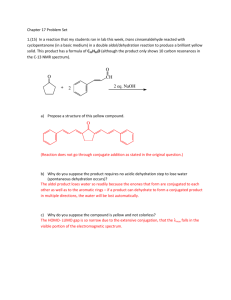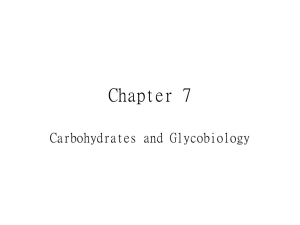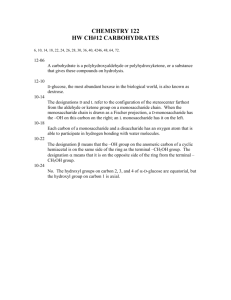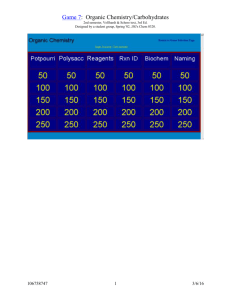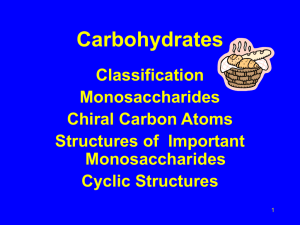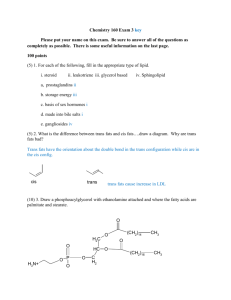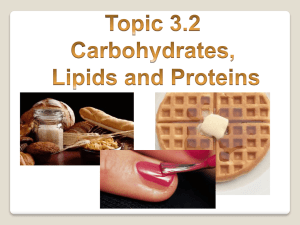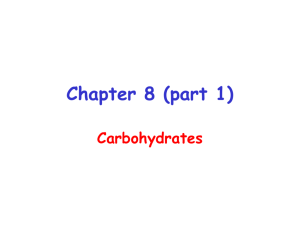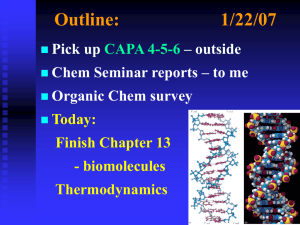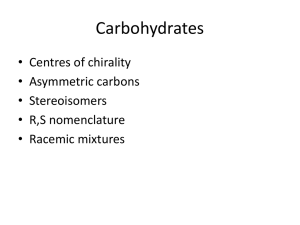chapter 17 lecture (ppt file)
advertisement
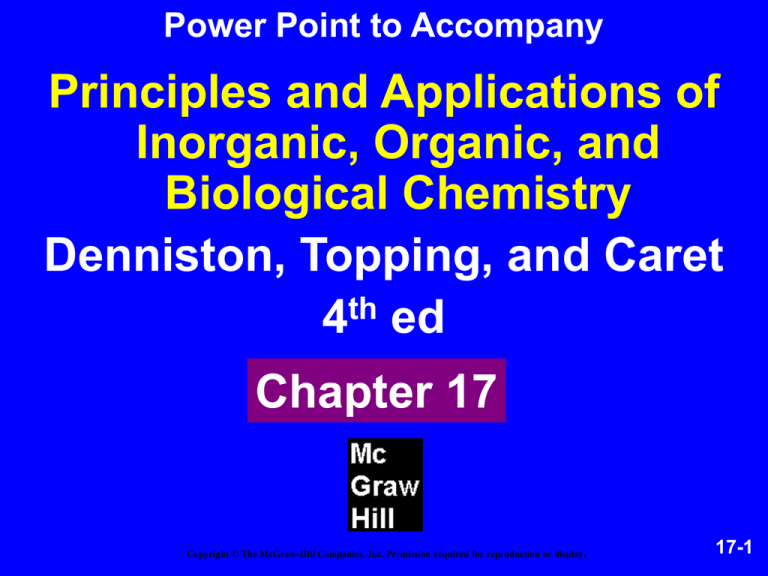
Power Point to Accompany Principles and Applications of Inorganic, Organic, and Biological Chemistry Denniston, Topping, and Caret th 4 ed Chapter 17 Copyright © The McGraw-Hill Companies, Inc. Permission required for reproduction or display. 17-1 Introduction • Carbohydrates are synthesized by photosynthesis in plants. • Grains, cereals, bread, sugar cane • Glucose is major energy source • A gram of digested carbohydrate gives about 4 kcal of energy • Complex carbs are best for diet • USDA recommends about 58% daily calories from carbs (not simple sugars) 17-2 17.1 Carbohydrate Types Monosaccharides E. g. glucose, fructose one sugar (saccharide) molecule Disaccharides E. g. sucrose, lactose Two monosaccharides linked Polysaccharides E. g. starch, glycogen, cellulose Chains of linked monosaccharide units 17-3 17.2 Monosaccharides polyhydroxy Aldehydes are aldoses Number of carbons Ketones are ketoses 3=triose 4=tetrose 5=pentose 6=hexose 17-4 Three carbon monosaccharides D-glyceraldehyde Is an aldotriose CH2OH O C H H C OH CH2OH C O dihydroxy acetone CH2OH Is a ketotriose 17-5 17.3 Stereoisomers and Stereochemistry Prefixes D- and L- in a monosaccharide name identify one of two isomeric forms. The isomers (same formula) differ in the spatial arrangement of atoms and are stereoisomers. The stereoisomers D- and L- glyceraldehyde are nonsuperimposable mirror image molecules and are called enantiomers (a subset of stereoisomers). 17-6 Stereoisomers and Stereochemistry Molecules that can exist in enantiomeric forms are said to be chiral. Chirality in glyceraldehyde is conveyed by a chiral (asymmetric) carbon-one with four different groups attached. 17-7 Glyceraldehyde has a stereocenter (chiral) carbon and thus has two enantiomers (nonsuperimposable mirror image molelcules) The D isomer has the OH on the stereocenter to the right. The L isomer has the OH on the stereocenter to the left. O H Mirror plane Stereocenter: C connected to four H C OH different atoms or groups CH2OH the D isomer O C H HO C H CH2OH the L isomer17-8 Optical Activity Enantiomers are also called optical isomers. Pasteur, in 1848, showed that enantiomers interact with plain polarized light to rotate the plane of the light in opposite directions. This interaction with polarized light is called optical activity and distinguishes the isomers. It is measured in a device called a polarimeter. A discussion of plane polarized light follows. 17-9 Polarized Light-1 Normal light vibrates in an infinite number of directions perpendicular to the direction of travel. When the light passes through a polarizing filter (Polaroid sunglasses, for example) only light vibrating in one plane reaches the other side of the filter. The diagram on the next slide illustrates this idea. The diagram is of a polarimeter, the instrument used to measure rotation of plain polarized light. 17-10 Polarized Light-2 Analyzer polaroid Rotated beam polarizer Light vibration in many directions Polarized light plane being rotated in sample tube. Polarized light vibrating in vertical plane. 17-11 Optical Activity-again When an enantiomer in a solution is placed in the polarimeter, the plane of rotation of the polarized light is rotated. One enantiomer always rotates light in a clockwise (+) direction and is said to be the dextrorotatory isomer. The other isomer rotates the light in a counterclockwise (-) direction and is the levorotatory isomer. Under identical conditions, the enantiomers always rotate light to exactly the same degree but in opposite directions. 17-12 Fischer Projections A Fischer projection uses lines crossing through a chiral carbon to represent bonds projecting out of the page (horizontal lines) or bonds projecting into the page (vertical lines). Compare the wedge vs the Fischer pictures below for glyceraldehyde. CHO CHO H C OH H CH2OH OH CH2OH the D isomer CHO CHO HO C H HO CH2OH H CH2OH the L isomer 17-13 The D- and L-System Monosaccharides are drawn in Fischer projections with the most oxidized carbon closest to the top. The carbons are numbered from the top. If the chiral carbon with the highest number has the OH to the right, the sugar is D. If the OH is to the left, the sugar is L. Most common sugars are in the D form. 17-14 O C 1 H 2 H C OH 3 CH2OH 2 C O 3 HO C H H C OH 4 1 CH2OH D-erythrose an aldotetrose 4 H C OH 5 H C OH CH2OH D-fructose a ketohexose 17-15 6 CHO CHO H C OH HO C H H C OH H C OH HO C H HO C H H C OH H C OH CH2OH CH2OH D-glucose D-galactose an aldohexose an aldohexose These diastereomers are also epimers, they differ in configuration at only one 17-16 stereocenter (colored dot). 17.4 Biological Monosaccharides Glucose is the most important sugar in the human body. Its concentration in the blood is regulated by insulin and glucagon. Under physiological conditions, glucose exists in a cyclic hemiacetal form where the C-5 OH reacts with the aldehyde. Two isomers (anomers) are formed which differ in the location of the OH on the acetal carbon, C-1. (Next slide) 17-17 Cyclic Form for Glucose The cyclic form of glucose is shown as a Haworth projection. CH2OH arrows show electron movement CH2OH O H H H H OH H O HO H OH H H OH HO H O H form (alpha) H OH OH Pyranose ring form CH2OH O OH H H form OH H (beta) HO H H OH Haworth projections 17-18 Cyclic Form for Glucose-cont. Fischer to Haworth projections Draw ring with O at upper right. O 1 H C OH 2 H C OH 3 HO C H O Groups to the 6 4 left go up on CH OH 2 H C OH 5 the Haworth 5 O H H HOCH2 C H ring. H 6 4 1 OH H - D-glucose HO 3 H OH OH 2 17-19 Fructose (Levulose or Fruit Sugar) Found in honey, corn syrup, and sweet fruits. The sweetest of sugars! CH2OH 1 CH2OH CH OH O 2 2 C O OH H 3 HO 4C H OHH H 5C OH CH2OH H 6C OH OH CH2OH O D-fructose CH2OH H OHH 17-20 Galactose ( in lactose/milk sugar) -D-galactoseamine is a component of the blood group antigens. 1 CHO 2 H C OH 3 HO 4C H HO C H 5 H C OH 6 CH2OH CH2OH HO OH H OH H OH H H OH -D-galactose 17-21 Ribose Ribose also exists mainly in the cyclic form CHO H C OH H C OH H C OH CH2OH CH2OH H O H H OH H OH OH -D-ribose Deoxyribose has an H here replacing the OH 17-22 Reducing Sugars Aldehydes of aldoses are oxidized by Benedict’s reagent, an alkaline copper(II) solution. The blue color fades as reaction occurs and a ppt forms. Test measures glucose in urine. O H C H C OH +2 Cu2+ CH2OH O O C H C OH CH2OH + Cu2O (red-orange) 17-23 Reducing Sugars All monosaccharides and the disaccharides except sucrose are reducing sugars. Ketoses can isomerize to aldoses. CH2OH HO CH O CH C OH CO H C OH HO C H HO C H HO C H H C OH H C OH H C OH H C OH H C OH H C OH CH2OH CH2OH CH2OH D-fructose enediol D-glucose17-24 A Reduced Sugar The most important reduced sugar is deoxyribose. (In DNA) O H C H C H H C OH H C OH CH2OH D-deoxyribose CH2OH O OH H H H H OH H -D-2-deoxyribose 17-25 17.5 Disaccharides The anomeric OH can react with another OH on an alcohol or sugar. Water is lost to form an acetal. Acetal link: R-O-C-O-R CH2OH H O OH H OH H HO H H OH + CH3 OH CH2OH H O O CH3 H OH H HO H H OH Acetal + H2O carbon 17-26 Disaccharides: Sucrose Sucrose is formed by linking D-glucose with D-fructose (acetal link=1) to give a 1,2 glycosidic link. CH2OH H H OH HO H O H HO CH2 H 1 O OH 2 H O H OH HO H CH2OH Sucrose is table sugar and is linked to dental caries. It is nonreducing. The glycosidic O 17-27 is part of an acetal and a ketal. Disaccharides: Lactose Lactose is formed by joining D-galactose to D-glucose to give a 1,4 glycoside CH2OH HO H O H OH H CH2OH O H H 1 4 O H H OH -D-galactose H OH H OH H OH -D-glucose Lactose is milk sugar. Lactose intolerance results from lack of lactase to hydrolyze the 17-28 glycosidic link of lactose. Disaccharides:Galactosemia In order for lactose to be used as an energy source, galactose must be converted to a phosphorylated glucose molecule. When enzymes necessary for this conversion are absent, the genetic disease galactosemia results. People who lack the enzyme lactase (~20%) are unable to digest lactose and have the condition called lactose intolerance. 17-29 Disaccharides: Maltose Maltose is formed by linking two -D-glucose molecules to give a 1,4 glycosidic link. CH2OH CH2OH O O H H H H H H OH H OH H O OH HO H OH H OH Maltose is malt sugar. It is formed when starch is partly hydrolyzed. It is a reducing sugar due to the free acetal. 17-30 Disaccharides:Cellobiose Cellobiose is formed by linking two Dglucose molecules to give a 1,4 glycosidic link. It comes from hydrolyzed cellulose. CH2OH CH2OH O O H H OH H H O OH H OH H H HO H H OH H OH 17-31 17.6 Polysaccharides: Cellulose Cellulose is the major structural polymer in plants. It is a liner homopolymer composed of -D-glucose units linked -1,4. The repeating disaccharide of cellulose is -cellobiose. Animals lack the enzymes necessary to hydrolyze cellulose. The bacteria in ruminants (eg. cows) can digest cellulose so that they can eat grass, etc. 17-32 Structure of Cellulose -(1->4) glycosidic bond CH2OH O H O CH2OH H OH H CH2OH O H H O H O H H OH OH H O H H OH H H H OH O H OH 17-33 Polysaccharides: Starch Starches are storage forms of glucose found in plants. They are polymers of linked glucose. If the links are only 1,4, the polymer is linear and is called amylose. (Figure on next slide.) Amylose usually assumes a helical configuration with six glucose units per turn. If the links are both 1,4 and 1,6, the polymer is branched and is called amylopectin. (Figure on next slide. 17-34 Polysaccharides: amylose/amylopectin CH2 OH CH2 OH CH2 OH CH2 OH O H H O H H O H H O H H H H H H ( OH H OH H OH H OH H O O O O O) H OH H OH H OH H OH amylose(-1,4 links) CH2 OH O H H H ( OH H O O H OH CH2 OH O H H H H ( OH H O O H OH CH2 OH O H H H OH H O amylopectin (-1,6 link) H OH CH2 CH2 OH CH2 OH O H H O H H O H H H H OH H OH H OH H O O O) H OH H OH H OH 17-35 Polysaccharides: glycogen The storage carbohydrate in animals is glycogen. It is a branched chain polymer like amylopectin but it has more frequent branching (about every 10 residues). Glycogen is stored in liver and muscle cells. 17-36 Glycoproteins These materials contain carbohydrate residues on protein chains. Very important examples of these materials are antibodies-chemicals which bind to antigens and immobilize them. The carbohydrate part of the glycoprotein plays a role in determining the part of the antigen molecule to which the antibody binds. 17-37 Glycoproteins: 2 The human blood groups A, B, AB, and O depend on the oligosaccharide part of the glycoprotein on the surface of erythrocyte cells. The terminal monosaccharide of the glycoprotein at the nonreducing end determines blood group. 17-38 Glycoproteins: 3 Type A Terminal sugar N-acetylgalactosamine B -D-galactose AB both the above O neither of the above O is the “universal donor” AB is the “universal acceptor” 17-39 The End Carbohydrates 17-40
